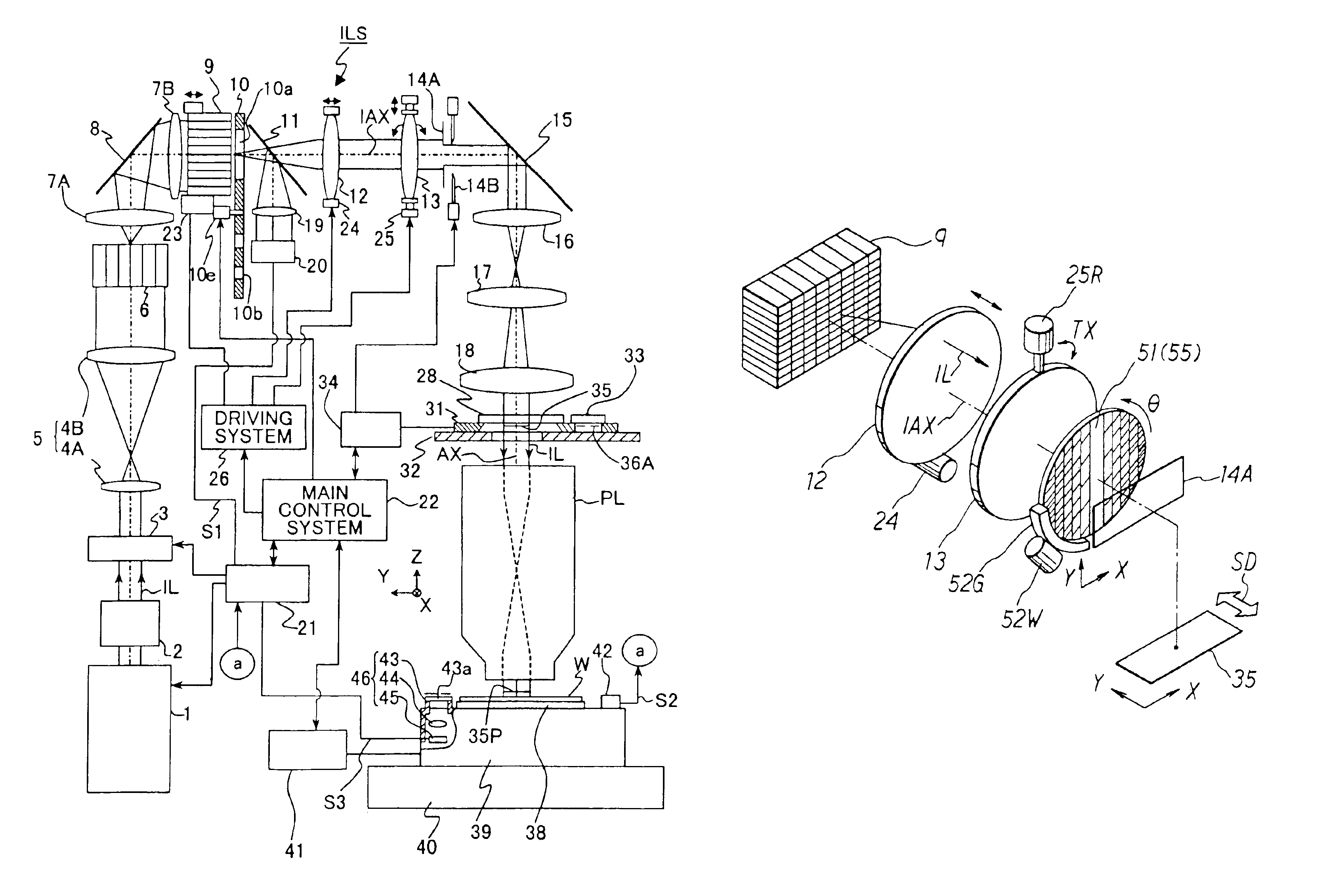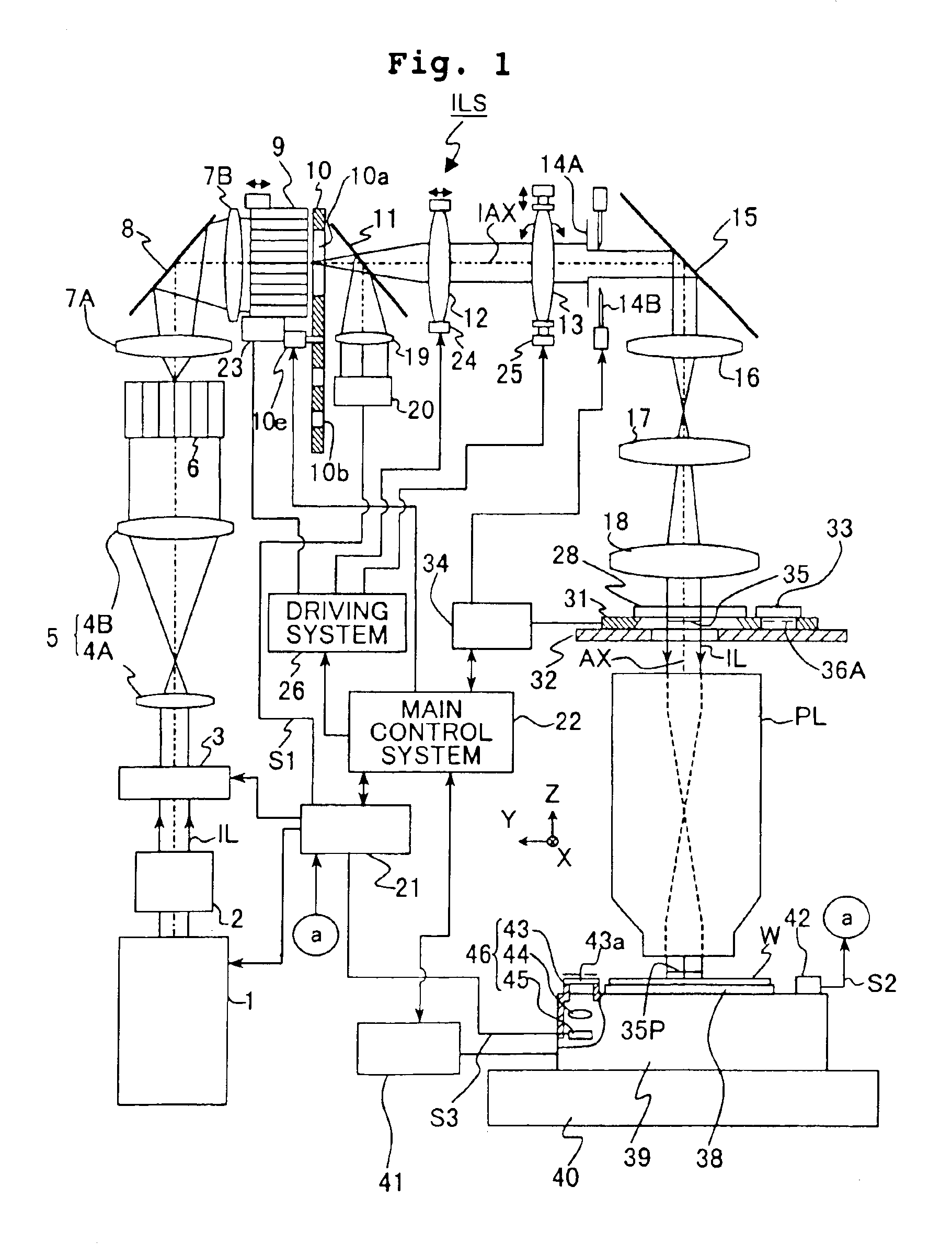Exposure apparatus and exposure method capable of controlling illumination distribution
- Summary
- Abstract
- Description
- Claims
- Application Information
AI Technical Summary
Benefits of technology
Problems solved by technology
Method used
Image
Examples
first embodiment
[0109]FIG. 1 shows a schematic arrangement of a projection exposure apparatus of this embodiment. In FIG. 1, an ArF excimer laser light source (wavelength: 193 nm) is used as an exposure light source 1. However, those usable as the exposure light source 1 include, for example, a KrF excimer laser (wavelength: 248 nm), an F2 laser (wavelength: 157 nm), a Kr2 laser (wavelength: 146 nm), a high harmonic wave generator of YAG laser, a high harmonic wave generator of semiconductor laser, and a mercury lamp. An exposure light beam IL (exposure beam), which is composed of an ultraviolet pulse light beam having a wavelength of 193 nm radiated from the exposure light source 1, passes through a beam matching unit (BMU) 2 for positionally matching the optical path with respect to the main exposure apparatus body, and it comes into a variable light-reducing unit 3 to serve as a light attenuator. An exposure control unit 21, which is provided to control the exposure amount with respect to the ph...
second embodiment
[0162]Next, explanation will be made for an example of the adjusting method adopted when the modified illumination is performed by installing the aperture diaphragm 10b for the zonal illumination (or the aperture diaphragm 10c for the four-spot illumination) at the light-outgoing plane of the second fly's eye lens 9 as shown in FIG. 6A with the illumination optical system of this embodiment.
[0163]In this case, the light amount distribution-converting element 55, which is composed of a diffractive optical element (DOE), is installed in place of the first fly's eye lens 6 shown in FIG. 1. In place of the diffractive optical element, a prism including, for example, a conical prism (axicon for zonal illumination) and a prism of the quadrangular pyramid type (pyramid type) (for four-spot illumination) may be used. In order to adjust the illumination area of the exposure light beam IL with respect to the second fly's eye lens 9 depending on whether the aperture diaphragm to be used is the...
third embodiment
[0177]This embodiment is illustrative of a case in which a filter (member) of the present invention is used. FIG. 11 shows a schematic arrangement of a scanning exposure type projection exposure apparatus based on the step-and-scan system of this embodiment. This exposure apparatus has substantially the same structure as that of the exposure apparatus according to the first embodiment except that a concentration filter plate 51 corresponding to a planer area with a variable transmittance distribution is provided, the driving system for the fly's eye lens 9 is not provided, and the structure of the driving system 25 is different from that in the first embodiment.
[0178]The concentration filter plate 51 is provided in the illumination optical system ISL. More specifically, the concentration filter plate 51 is arranged at the plane which is further defocused by a predetermined amount from the fixed blind 14A, i.e., at the plane which is slightly defocused from the conjugate plane with r...
PUM
 Login to View More
Login to View More Abstract
Description
Claims
Application Information
 Login to View More
Login to View More - R&D
- Intellectual Property
- Life Sciences
- Materials
- Tech Scout
- Unparalleled Data Quality
- Higher Quality Content
- 60% Fewer Hallucinations
Browse by: Latest US Patents, China's latest patents, Technical Efficacy Thesaurus, Application Domain, Technology Topic, Popular Technical Reports.
© 2025 PatSnap. All rights reserved.Legal|Privacy policy|Modern Slavery Act Transparency Statement|Sitemap|About US| Contact US: help@patsnap.com



